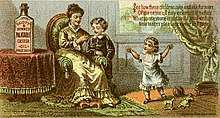Palatability
Palatability is the hedonic reward (i.e., pleasure) provided by foods or fluids that are agreeable to the "palate", which often varies relative to the homeostatic satisfaction of nutritional, water, or energy needs.[1] The palatability of a food or fluid, unlike its flavor or taste, varies with the state of an individual: it is lower after consumption and higher when deprived. It has increasingly been appreciated that this can create a hunger that is independent of homeostatic needs.[2]
Brain mechanism

The palatability of a substance is determined by opioid receptor-related processes in the nucleus accumbens and ventral pallidum.[3] The opioid processes involve mu opioid receptors and are present in the rostromedial shell part of the nucleus accumbens[4] on its spiny neurons.[5] This area has been called the "opioid eating site".[6]
The rewardfulness of consumption associated with palatability is dissociable from desire or incentive value which is the motivation to seek out a specific commodity.[3] Desire or incentive value is processed by opioid receptor-related processes in the basolateral amygdala.[3] Unlike the liking palatability for food, the incentive salience wanting is not downregulated by the physiological consequences of food consumption and may be largely independent of homoeostatic processes influencing food intake.[7]
Though the wanting of incentive salience may be informed by palatability it is independent and not necessarily reduced to it.[3] It has been suggested that a third system exists that links opioid processes in the two parts of the brain: "Logically this raises the possibility that a third system, with which the accumbens shell, ventral pallidum, and basolateral amygdala are associated, distributes the affective signals elicited by specific commodities across distinct functional systems to control reward seeking... At present we do not have any direct evidence for a system of this kind, but indirect evidence suggests it may reside within the motivationally rich circuits linking hypothalamic and brainstem viscerogenic structures such as the parabrachial nucleus.[3]
It has also been suggested that "hedonic hunger" can be driven both in regard to “wanting” and “liking”[2] and that a palatability subtype of neuron may also exist in the basolateral amygdala.[8]
Satiety and palatability
Appetite is controlled by a direct loop and an indirect one. In both the direct and indirect loops there are two feedback mechanisms. First a positive feedback involving its stimulation by palatability food cues, and second, a negative feedback due to satiation and satiety cues following ingestion.[9] In the indirect loop these cues are learnt by association such as meal plate size and work by modulating the potency of the cues of the direct loop.[10] The influence of these processes can exist without subjective awareness.[11]
The cessation of a desire to eat after a meal "satiation" is likely to be due to different processes and cues.[12] More palatable foods reduce the effects of such cues upon satiation causing a larger food intake.[13][14] In contrast, unpalatability of certain foods can serve as a deterrent from feeding on those foods in the future. For example, the Variable Checkerspot butterfly contains iridoid compounds that are unpalatable to avian predators, thus reducing the risk of predation.[15]
See also
- Acquired taste
- Flavor
- Food craving
- Motivation
- Nutrition
- Pleasure center
References
- Friedman MI, Stricker EM. (1976). The physiological psychology of hunger: a physiological perspective. Psychol Rev. 83(6):409-31. PMID 1005583
- Lowe MR, Butryn ML. (2007). Hedonic hunger: a new dimension of appetite? Physiol Behav. Jul 24;91(4):432-9. PMID 17531274
- Wassum KM, Ostlund SB, Maidment NT, Balleine BW. (2009). Distinct opioid circuits determine the palatability and the desirability of rewarding events. Proc Natl Acad Sci U S A. 106:12512–12517 PMID 19597155 doi:10.1073/pnas.0905874106
- Peciña S, Berridge KC. (2005). Hedonic hot spot in nucleus accumbens shell: where do mu-opioids cause increased hedonic impact of sweetness? J Neurosci. 14;25(50):11777-86. doi:10.1523/JNEUROSCI.2329-05.2005 PMID 16354936
- Kelley AE, Bakshi VP, Haber SN, Steininger TL, Will MJ, Zhang M. (2002). Opioid modulation of taste hedonics within the ventral striatum. Physiol Behav. 76(3):365-77. PMID 12117573
- Peciña S, Berridge KC. (2000).Opioid site in nucleus accumbens shell mediates eating and hedonic 'liking' for food: map based on microinjection Fos plumes. Brain Res. 863(1-2):71-86. PMID 10773195
- Finlayson G, King N, Blundell J. (2008). The role of implicit wanting in relation to explicit liking and wanting for food: implications for appetite control. Appetite. 50(1):120-7. PMID 17655972
- Fontanini A, Grossman SE, Figueroa JA, Katz DB. (2009). Distinct subtypes of basolateral amygdala taste neurons reflect palatability and reward. J Neurosci. 29(8):2486-95. PMID 19244523
- Smith GP. (2000). The controls of eating: a shift from nutritional homeostasis to behavioral neuroscience. Nutrition. 16(10):814-20. PMID 11054585
- Smith GP. (1996). The direct and indirect controls of meal size. Neurosci Biobehav Rev. 20(1):41-6. PMID 8622828
- Berridge KC. (1996). Food reward: brain substrates of wanting and liking. Neurosci Biobehav Rev.; 20(1):1-25. PMID 8622814
- Blundell JE. Rogers PJ. (1991). Hunger, hedonics, and the control of satiation and satiety. pp. 127–148. In: M.I. Friedman, M.G. Tordoff and M.R. Kare, (Editors) Appetite and nutrition, Dekker, New York ISBN 978-0-8247-8371-6
- Yeomans MR, Lee MD, Gray RW, French SJ. (2001). Effects of test-meal palatability on compensatory eating following disguised fat and carbohydrate preloads. Int J Obes Relat Metab Disord. 25(8):1215-24. PMID 11477507
- Robinson TM, Gray RW, Yeomans MR, French SJ. (2005).Test-meal palatability alters the effects of intragastric fat but not carbohydrate preloads on intake and rated appetite in healthy volunteers. Physiol Behav. 84(2):193-203. PMID 15708771
- Bowers, M. D. "Unpalatability as a Defense Strategy of Western Checkerspot Butterflies (Euphydryas Scudder, Nymphalidae)." Evolution 35.2 (1981): 367-75.
External links
- The effect of palatability on satiety Martin R Yeomans